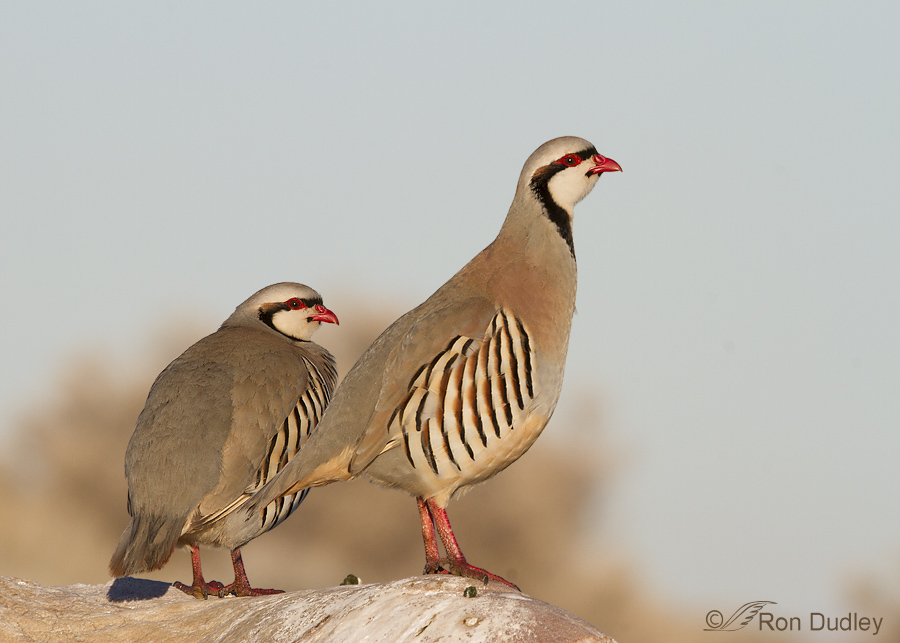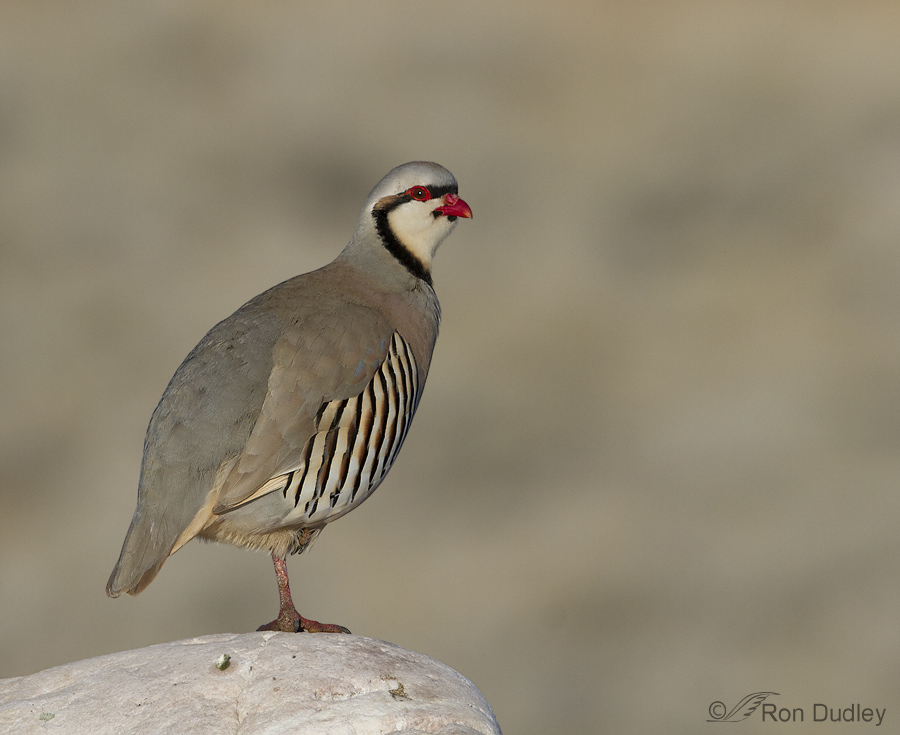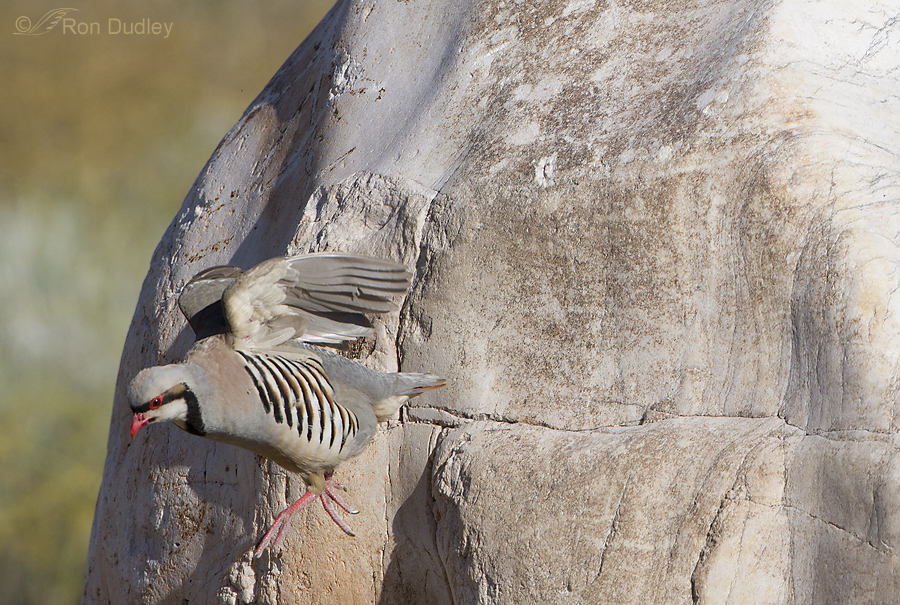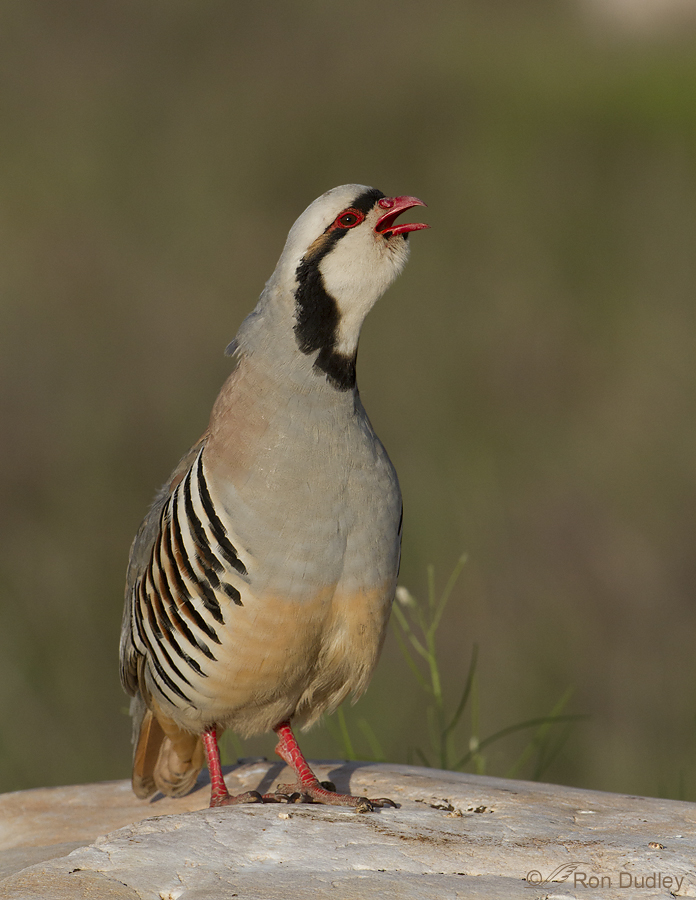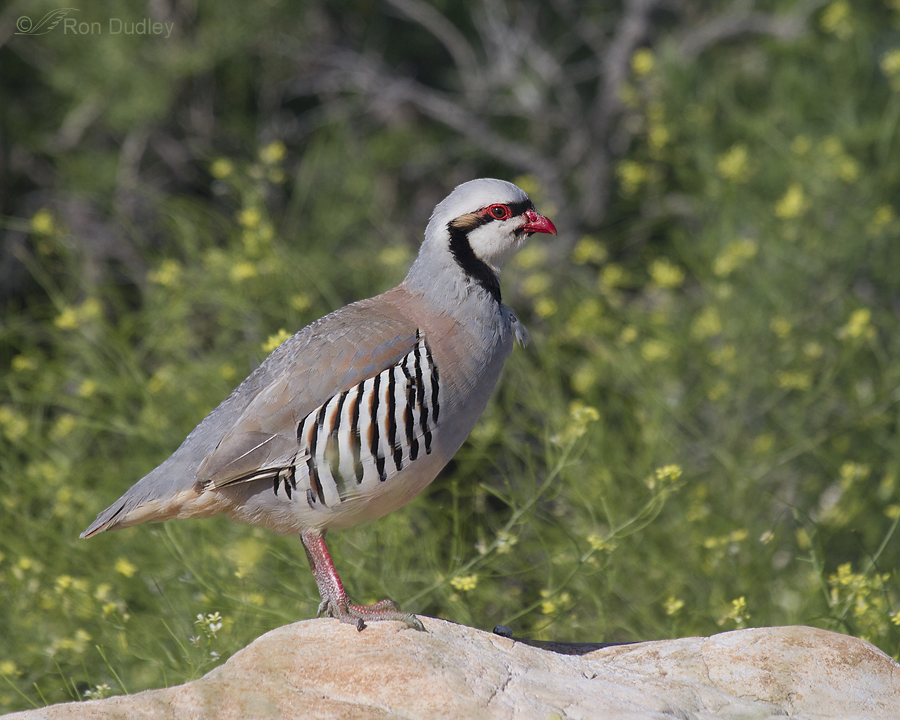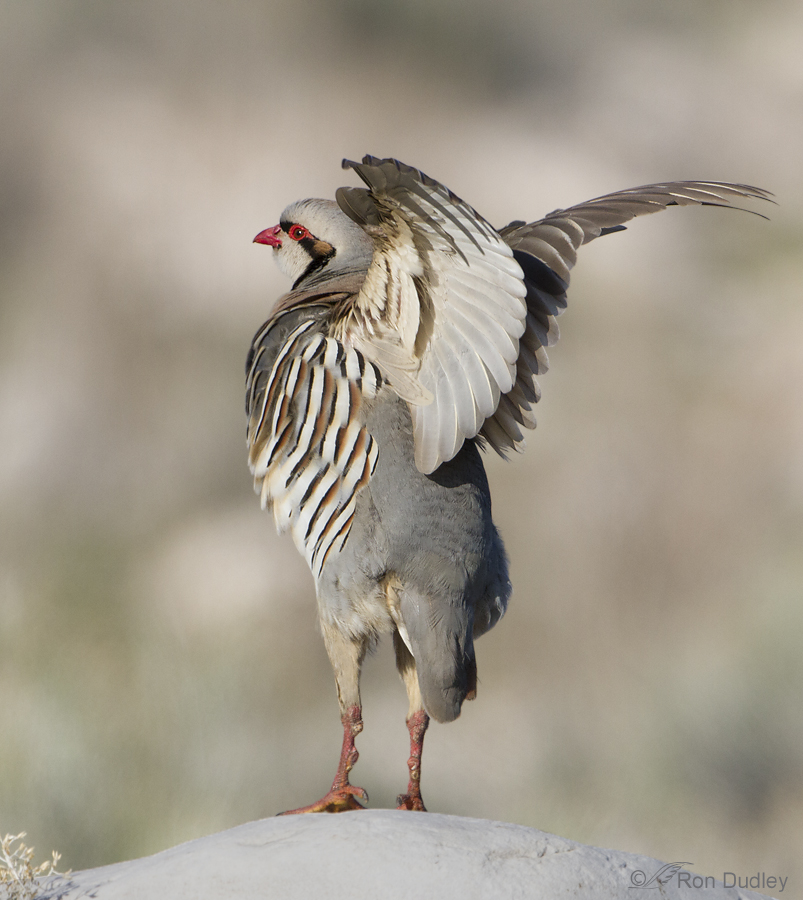Tag: chukar
Finally! – Another Cooperative Chukar
Chukar Calling On One Foot
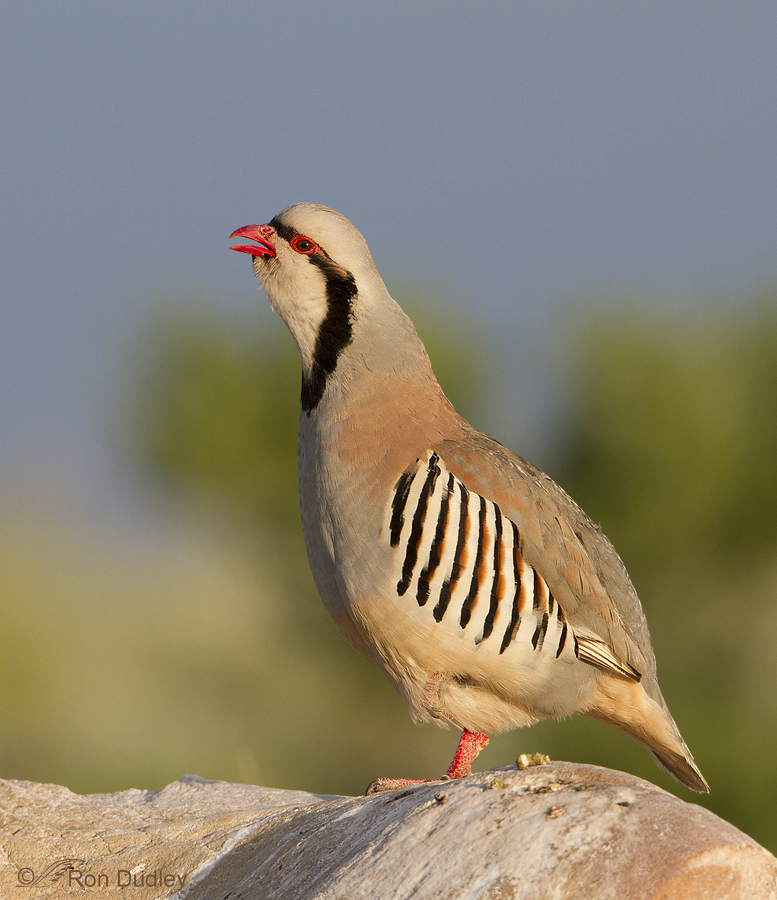
Chukars continue to be one of my preferred subjects during the winter and spring due to their distinctive and colorful plumage and their often comical behavior. They are abundant on Antelope Island and even somewhat approachable there – at least in comparison to their skittish and wily ways elsewhere (hunters consider them to be among the most challenging of upland game species).
Chukar Free Fall
Plumage-challenged Chukar
Chukar Served With Black Mustard
Chukar – Wing Stretch On Tippytoes
Chukars Descending
I’ve mentioned before how very reluctant Chukars are to fly. They much prefer to scurry away through the grasses whenever they feel insecure or threatened.
And that reluctance also applies when they’re ready to leave an elevated perch. They’ll nearly always find a way to scramble down a big rock rather than fly from it like most other birds would. That tendency was demonstrated to me twice yesterday morning on Antelope Island.
Chukar Contrasts
Early last Sunday morning was a good time for Chukars on Antelope Island. It was too early for the weekend crowds who were mostly still home snoozing away, the light was great and the Chukars cooperative.
A Chukar Sentry Abandons Its Post
I’ve never been able to get a Chukar in flight or taking off, largely because they’re so hesitant to fly. Even when they’re perched on an elevated rock they usually just hop to the ground when they’re ready to leave. And when they do fly, typical of most upland game birds, they fly very fast, low to the ground and away from you which makes for an almost impossible target. But I got one yesterday morning, taking off. 1/5000, f/5.6, ISO 500, 100-400 @260mm, natural light This bird was acting as a sentry (also called a sentinel) for a small group of other Chukars nearby. It’s observation perch of choice was a sign post that was high enough that it had to actually fly when it decided to leave. I was too close to this bird for my 500mm lens so I quickly grabbed my 100-400 zoom lens and when it looked like it might be thinking of taking off I zoomed back far enough to give the Chukar enough room to fly into. I had plenty of light for a shutter speed fast enough to freeze the wings of even this buzz-saw flier (those relatively short wings on such a chunky bird really have to churn to get it airborne) and was lucky enough to catch the wings in a position I like. A more appealing perch would have been nice but I’m pleased with the way most everything else turned out. Ron
Chukars – More Accessible During Springtime
Our Chukars are generally easier to approach in the spring and early summer than they are the rest of the year. Right now, pair bonds are being formed and the birds seem more concerned with others of their own kind than they are about me and my pickup.
Chukar On A Snow-covered Rock Ledge
Sometimes a change of position of just a few inches can have a fairly dramatic affect on the overall “feel” of an image. That was the case with this Antelope Island Chukar. 1600, f/8, ISO 400, 500 f/4, 1.4 tc, natural light I found the bird on a rock ledge and slightly above me which gave an almost eye-level perspective that I like. Occasionally it would call, as they’re very prone to do. 1600, f/8, ISO 400, 500 f/4, 1.4 tc, natural light But then it began to walk a short distance to my right (I’m always surprised that the bottoms of their feet are yellow)… 1600, f/7.1, ISO 400, 500 f/4, 1.4 tc, natural light which brought the snow-covered hillside in the background into play. At first there was a mix of snow and blue sky back there… 2000, f/7.1, ISO 400, 500 f/4, 1.4 tc, natural light but then I deliberately raised my window a couple of inches (as usual I was shooting from my pickup) to take the blue sky out of the picture. And the bird obliged me by calling once again. Most of the snow is finally gone from the island now. Even the roads to the Frary Peak trailhead and White Rock Bay are open – they’ve been closed for months due to snow. Hopefully that’s a sign that the curlews and Willets (and other spring birds) won’t be far behind. Hope so – it’s been a long dry spell on the island. Ron
Some Random Recent Images
I have an appointment early this morning so I don’t have time for a detailed, organized post so I thought I’d present a little potpourri from the last few weeks. Though none of these images are spectacular, there’s something about each one of them that appealed to me in some way. Common Ravens are a hugely challenging subject for me because of their uncooperative behavior and the difficulty of getting detail in the blacks. For some reason, these birds really seem to eat a lot of snow, which this one had been doing just before take-off. I do wish the head were slightly sharper but I like the remnants of the snow-eating behavior and how cleanly the bird is presented against the background which is the Great Salt Lake with the snow-covered shoreline at bottom right. Finding water that isn’t ice-covered around here isn’t easy, for me or for the critters, but I think that’s the only reason this Muskrat came as close to me as it did. I found this one at a pond close to my home. Ok, not a classic wing position for sure but the aerodynamic profile of this fast flying Prairie Falcon still appealed to me. I also like the eye contact and crisp detail in flight. Life is tough for Coyotes right now as they live in a stark white world of deep snow which makes survival difficult. Many of them wear an almost perpetual snow mask from pushing their faces through the snow as they try to follow…
Snow-hoppin’ Chukar
Chukars typically forage in small flocks and when they do one of them often sits on an elevated perch and serves as a sentry while the others are looking for food. 1/2500, f/8, ISO 500, 100-400 @ 400mm, natural light This bird chose a pile of snow that had been pushed up high by a snow plow along the edge of a road. 1/3200, f/8, ISO 500, 100-400 @ 400mm, natural light When the rest of the flock wandered off it decided it was time to look for a safe way down from its lofty perch. 1/2500, f/8, ISO 500, 100-400 @ 400mm, natural light When they do so they’re very deliberate about it. This bird investigated several pathways down before settling on this direction. It’s quite a ways down so “he” was pretty careful about it. 1/2500, f/8, ISO 500, 100-400 @ 400mm, natural light Most birds would at least open their wings to soften the landing. Not Chukars. I’ve often been impressed by how far they’re willing to free-fall without using their wings. I sometimes refer to Chukars as “rock-hoppers” – guess I’ll have to add “snow-hoppers” to the list. Since I was using my 100-400mm zoom lens for this sequence I wish I’d had time to back off a bit on the focal length for the jump, but I didn’t. Consequently I had to add some canvas for composition. It’s harder to get them in mid-air, sharp and composed well than it looks. Ron
It’s Been A Tough Winter For Birds (and it’s getting worse)
Typical winters are hard on birds in northern Utah (and elsewhere). But when the season is unusually frigid with lots of snow as we’re having this year they struggle even more to survive. All of these images have been taken since January 2 of this year. Upland game birds like this Chukar seem to have adapted to extreme conditions fairly well. This bird was all puffed up and sitting high on a rock to catch the earliest warming rays of the sun as it rose over the nearby Wasatch Mountains. Another upland game species that can apparently take harsh conditions quite well is the Ring-necked Pheasant (this is a female). They seem to forage for seeds at the base of plants where the snow isn’t as thick and their food is more readily available. But many other species have a difficult time and quite a few birds don’t survive until spring. The waterfowl that winter over here congregate in the few areas of open water where the flowing water is the last to freeze over. But when it gets very cold, even those small bits of open water freeze. I’ve seen ducks and coots frozen into the ice, some of them still alive. This female Green-winged Teal has just left one of the last unfrozen patches of water and is approaching an area of frost flowers. This Northern Flicker is using the protection of the underside of the eaves of a building on Antelope Island State Park. I thought the angled…
Finally! – Another Cooperative Chukar
Chukar Calling On One Foot

Chukars continue to be one of my preferred subjects during the winter and spring due to their distinctive and colorful plumage and their often comical behavior. They are abundant on Antelope Island and even somewhat approachable there – at least in comparison to their skittish and wily ways elsewhere (hunters consider them to be among the most challenging of upland game species).
Chukar Free Fall
Plumage-challenged Chukar
Chukar Served With Black Mustard
Chukar – Wing Stretch On Tippytoes
Chukars Descending
I’ve mentioned before how very reluctant Chukars are to fly. They much prefer to scurry away through the grasses whenever they feel insecure or threatened.
And that reluctance also applies when they’re ready to leave an elevated perch. They’ll nearly always find a way to scramble down a big rock rather than fly from it like most other birds would. That tendency was demonstrated to me twice yesterday morning on Antelope Island.
Chukar Contrasts
Early last Sunday morning was a good time for Chukars on Antelope Island. It was too early for the weekend crowds who were mostly still home snoozing away, the light was great and the Chukars cooperative.
A Chukar Sentry Abandons Its Post
I’ve never been able to get a Chukar in flight or taking off, largely because they’re so hesitant to fly. Even when they’re perched on an elevated rock they usually just hop to the ground when they’re ready to leave. And when they do fly, typical of most upland game birds, they fly very fast, low to the ground and away from you which makes for an almost impossible target. But I got one yesterday morning, taking off. 1/5000, f/5.6, ISO 500, 100-400 @260mm, natural light This bird was acting as a sentry (also called a sentinel) for a small group of other Chukars nearby. It’s observation perch of choice was a sign post that was high enough that it had to actually fly when it decided to leave. I was too close to this bird for my 500mm lens so I quickly grabbed my 100-400 zoom lens and when it looked like it might be thinking of taking off I zoomed back far enough to give the Chukar enough room to fly into. I had plenty of light for a shutter speed fast enough to freeze the wings of even this buzz-saw flier (those relatively short wings on such a chunky bird really have to churn to get it airborne) and was lucky enough to catch the wings in a position I like. A more appealing perch would have been nice but I’m pleased with the way most everything else turned out. Ron
Chukars – More Accessible During Springtime
Our Chukars are generally easier to approach in the spring and early summer than they are the rest of the year. Right now, pair bonds are being formed and the birds seem more concerned with others of their own kind than they are about me and my pickup.
Chukar On A Snow-covered Rock Ledge
Sometimes a change of position of just a few inches can have a fairly dramatic affect on the overall “feel” of an image. That was the case with this Antelope Island Chukar. 1600, f/8, ISO 400, 500 f/4, 1.4 tc, natural light I found the bird on a rock ledge and slightly above me which gave an almost eye-level perspective that I like. Occasionally it would call, as they’re very prone to do. 1600, f/8, ISO 400, 500 f/4, 1.4 tc, natural light But then it began to walk a short distance to my right (I’m always surprised that the bottoms of their feet are yellow)… 1600, f/7.1, ISO 400, 500 f/4, 1.4 tc, natural light which brought the snow-covered hillside in the background into play. At first there was a mix of snow and blue sky back there… 2000, f/7.1, ISO 400, 500 f/4, 1.4 tc, natural light but then I deliberately raised my window a couple of inches (as usual I was shooting from my pickup) to take the blue sky out of the picture. And the bird obliged me by calling once again. Most of the snow is finally gone from the island now. Even the roads to the Frary Peak trailhead and White Rock Bay are open – they’ve been closed for months due to snow. Hopefully that’s a sign that the curlews and Willets (and other spring birds) won’t be far behind. Hope so – it’s been a long dry spell on the island. Ron
Some Random Recent Images
I have an appointment early this morning so I don’t have time for a detailed, organized post so I thought I’d present a little potpourri from the last few weeks. Though none of these images are spectacular, there’s something about each one of them that appealed to me in some way. Common Ravens are a hugely challenging subject for me because of their uncooperative behavior and the difficulty of getting detail in the blacks. For some reason, these birds really seem to eat a lot of snow, which this one had been doing just before take-off. I do wish the head were slightly sharper but I like the remnants of the snow-eating behavior and how cleanly the bird is presented against the background which is the Great Salt Lake with the snow-covered shoreline at bottom right. Finding water that isn’t ice-covered around here isn’t easy, for me or for the critters, but I think that’s the only reason this Muskrat came as close to me as it did. I found this one at a pond close to my home. Ok, not a classic wing position for sure but the aerodynamic profile of this fast flying Prairie Falcon still appealed to me. I also like the eye contact and crisp detail in flight. Life is tough for Coyotes right now as they live in a stark white world of deep snow which makes survival difficult. Many of them wear an almost perpetual snow mask from pushing their faces through the snow as they try to follow…
Snow-hoppin’ Chukar
Chukars typically forage in small flocks and when they do one of them often sits on an elevated perch and serves as a sentry while the others are looking for food. 1/2500, f/8, ISO 500, 100-400 @ 400mm, natural light This bird chose a pile of snow that had been pushed up high by a snow plow along the edge of a road. 1/3200, f/8, ISO 500, 100-400 @ 400mm, natural light When the rest of the flock wandered off it decided it was time to look for a safe way down from its lofty perch. 1/2500, f/8, ISO 500, 100-400 @ 400mm, natural light When they do so they’re very deliberate about it. This bird investigated several pathways down before settling on this direction. It’s quite a ways down so “he” was pretty careful about it. 1/2500, f/8, ISO 500, 100-400 @ 400mm, natural light Most birds would at least open their wings to soften the landing. Not Chukars. I’ve often been impressed by how far they’re willing to free-fall without using their wings. I sometimes refer to Chukars as “rock-hoppers” – guess I’ll have to add “snow-hoppers” to the list. Since I was using my 100-400mm zoom lens for this sequence I wish I’d had time to back off a bit on the focal length for the jump, but I didn’t. Consequently I had to add some canvas for composition. It’s harder to get them in mid-air, sharp and composed well than it looks. Ron
It’s Been A Tough Winter For Birds (and it’s getting worse)
Typical winters are hard on birds in northern Utah (and elsewhere). But when the season is unusually frigid with lots of snow as we’re having this year they struggle even more to survive. All of these images have been taken since January 2 of this year. Upland game birds like this Chukar seem to have adapted to extreme conditions fairly well. This bird was all puffed up and sitting high on a rock to catch the earliest warming rays of the sun as it rose over the nearby Wasatch Mountains. Another upland game species that can apparently take harsh conditions quite well is the Ring-necked Pheasant (this is a female). They seem to forage for seeds at the base of plants where the snow isn’t as thick and their food is more readily available. But many other species have a difficult time and quite a few birds don’t survive until spring. The waterfowl that winter over here congregate in the few areas of open water where the flowing water is the last to freeze over. But when it gets very cold, even those small bits of open water freeze. I’ve seen ducks and coots frozen into the ice, some of them still alive. This female Green-winged Teal has just left one of the last unfrozen patches of water and is approaching an area of frost flowers. This Northern Flicker is using the protection of the underside of the eaves of a building on Antelope Island State Park. I thought the angled…


